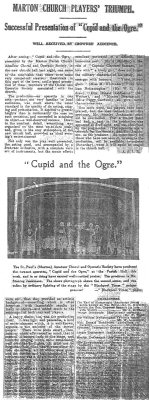|
 MARTON
CHURCH PLAYERS' TRIUMPH. MARTON
CHURCH PLAYERS' TRIUMPH.
Successful Presentation of "Cupid
and the Ogre."
Well received by crowded audience.
After seeing “Cupid and the Ogre,” presented by the Marton
Parish Church Amateur Choral and Operatic Society, in the new church hall last
night, one came to the conclusion that there were some very competent amateur
theatricals in this part of the town, and a good proportion of these, members
of the Choral and Operatic Society, associated with the church.
The production – an operetta in two
acts – perhaps not very familiar to local audiences, was much above the usual
standard in the quality of its acting, staging and presentation. It aspired to greater heights than is
customarily the case on such occasions, and succeeded in attaining its object –
a well deserved success. Down to the
smallest detail, everything was organised on the most up-to-date scale, and,
given in the cosy atmosphere of the new church hall, provided an ideal
evening’s entertainment.
Not only was the play well presented,
the acting good, and accompanied by a first-rate orchestra, with a complete
variety of instruments, but the scenic effects were such that they provided an
artistic background – something which is often forgotten, with lamentable
results by many amateurs – and added much to the enjoyment of both play and
players.
A happy choice,
too, was the production itself. It was
light and palatable, a kind of entertainment which, it is well-known, appeals
to the majority of the townspeople.
There were some smart lines, humour which effervesced so much that it
seemed to bounce back to the stage, and colourful singing which came remarkably
well over the footlights. It must not
be forgotten, too, that there were some fifteen characters, all of whom were
good, and the success and high standard of the performance was a direct result
of all the players entering wholeheartedly into their respective parts.
IMPORTANT TRIMMINGS
“Cupid and the Ogre” actually has a plot, but much of its
success may be attributed to its trimmings which embrace kingly kings, lordly
earls, and elegant ladies of high rank and station. Of course, there is a castle, pretty frocks, fresh and
rosy-complexioned young ladies, and much …and humour...[text illegible or
missing here]…excellent portrayal of a difficult but humorous part. Mr J. Hitchen, in the role of “Captain
Clarence Samazu,” in love with “a lovely girl,” does not forget the military
character of his study, and emerges with honours. “Violet Silverglade” (Miss M. Whittaker), “Sir William
Nottatoughm” (Mr. W. L. Andrew), “Hon. Donald Doddletrot (Mr. Webber), and
“Monica Dearmetutt” (Miss Peggy Cardwell) all give clever characterisations.
One more word, the players have been
praised, but the man behind it all – the producer, Mr. Stanley Jenkinson – must
not be overlooked. That a master hand
had a part in the production was apparent at first sight, and was confirmed by
the programme. The operetta was a
triumph for the society, and Mr. Jenkinson, as the producer. An opportunity for those who have not seen
it, to sample the production, will be available to-morrow (Saturday), when it
will again be staged in the church hall.
A. S. L. R.
|


